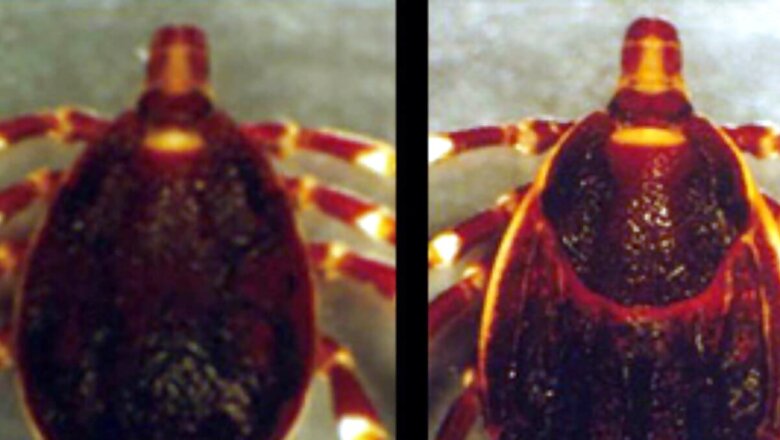
views
The discovery of a single case of Crimean-Congo Haemorrhagic Fever (CCHF) in Pakistan’s Peshawar has raised concern among the local health authorities ahead of Eid next month. After a case of “Congo Fever” was confirmed by the Khyber Medical University, the provincial health department urged for protective measures at all the animal markets.
Local authorities have been asked to close those animal markets that don’t comply with the directives regarding protective measures, the Dawn newspaper reported. These measures were taken after a “butcher” tested positive for CCHF and was being treated at Khyber Teaching Hospital, the newspaper said. This alarming concern came as last year four people died of the disease after they caught the virus from the animal market.
What exactly is Congo Fever?
Crimean-Congo haemorrhagic fever is a widespread disease caused by a tick-borne virus (Nairovirus) of the Bunyaviridae family, according to World Health Organisation (WHO). The CCHF virus causes severe viral haemorrhagic fever outbreaks, with a case fatality rate of 10–40%. CCHF is endemic in Africa, the Balkans, the Middle East and Asian countries south of the 50th parallel north – the geographical limit of the principal tick vector. The hosts of the CCHF virus include a wide range of wild and domestic animals such as cattle, sheep and goats.
Many birds are resistant to infection, but ostriches are susceptible and may show a high prevalence of infection in endemic areas, where they have been at the origin of human cases. For example, a former outbreak occurred at an ostrich abattoir in South Africa. There is no apparent disease in these animals. Animals become infected by the bite of infected ticks and the virus remains in their bloodstream for about one week after infection, allowing the tick-animal-tick cycle to continue when another tick bites. Although several tick genera are capable of becoming infected with CCHF virus, ticks of the genus Hyalomma are the principal vector.
Transmission
The CCHF virus is transmitted to people either by tick bites or through contact with infected animal blood or tissues during and immediately after slaughter. The majority of cases have occurred in people involved in the livestock industry, such as agricultural workers, slaughterhouse workers and veterinarians.
Human-to-human transmission can occur resulting from close contact with the blood, secretions, organs or other bodily fluids of infected persons. Hospital-acquired infections can also occur due to improper sterilization of medical equipment, reuse of needles and contamination of medical supplies.
Signs and symptoms
The length of the incubation period depends on the mode of acquisition of the virus. Following infection by a tick bite, the incubation period is usually one to three days, with a maximum of nine days. The incubation period following contact with infected blood or tissues is usually five to six days, with a documented maximum of 13 days.
Onset of symptoms is sudden, with fever, myalgia, (muscle ache), dizziness, neck pain and stiffness, backache, headache, sore eyes and photophobia (sensitivity to light). There may be nausea, vomiting, diarrhoea, abdominal pain and sore throat early on, followed by sharp mood swings and confusion. After two to four days, the agitation may be replaced by sleepiness, depression and lassitude, and the abdominal pain may localize to the upper right quadrant, with detectable hepatomegaly (liver enlargement).
Mortality rate
Other clinical signs include tachycardia (fast heart rate), lymphadenopathy (enlarged lymph nodes), and a petechial rash (a rash caused by bleeding into the skin) on internal mucosal surfaces, such as in the mouth and throat, and on the skin. The petechiae may give way to larger rashes called ecchymoses, and other haemorrhagic phenomena.
There is usually evidence of hepatitis, and severely ill patients may experience rapid kidney deterioration, sudden liver failure or pulmonary failure after the fifth day of illness. The mortality rate from CCHF is approximately 30%, with death occurring in the second week of illness. In patients who recover, improvement generally begins on the ninth or tenth day after the onset of illness.
Prevention and control
It is difficult to prevent or control CCHF infection in animals and ticks as the tick-animal-tick cycle usually goes unnoticed and the infection in domestic animals is usually not apparent. Furthermore, the tick vectors are numerous and widespread, so tick control with acaricides (chemicals intended to kill ticks) is only a realistic option for well-managed livestock production facilities.
For example, following an outbreak at an ostrich abattoir in South Africa (noted above), measures were taken to ensure that ostriches remained tick free for 14 days in a quarantine station before slaughter. This decreased the risk for the animal to be infected during its slaughtering and prevented human infection for those in contact with the livestock. There are no vaccines available for use in animals, according to WHO.
Stay informed with the Iranian President News Latest Updates..


















Comments
0 comment